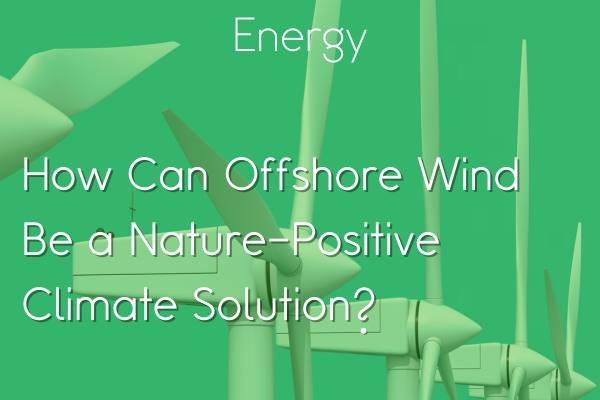How Can Offshore Wind Be a Nature-Positive Climate Solution?
06 Nov, 20242minsThe urgent need to address climate change has accelerated the deployment of offshore wind fa...

The urgent need to address climate change has accelerated the deployment of offshore wind farms across our oceans. While this renewable energy source is crucial for achieving net-zero emissions, we must ensure its expansion doesn't come at the expense of marine ecosystems. The good news? We can make offshore wind truly nature-positive through strategic planning and comprehensive environmental stewardship.
Understanding Nature-Positive Development
A nature-positive approach means going beyond simply minimizing environmental damage—it actively contributes to restoring and enhancing marine ecosystems while delivering clean energy. This dual benefit is essential, as healthy seas not only support biodiversity but also act as vital carbon sinks.
Key Strategies for Nature-Positive Offshore Wind
1. Strategic Site Selection
The foundation of nature-positive offshore wind begins with choosing the right locations. This means:
• Using robust ecological data and sensitivity mapping to identify areas with minimal impact on marine life
• Avoiding critical marine protected areas and migration corridors
• Maintaining buffer zones around sensitive habitats
2. Smart Design and Operation
Modern offshore wind farms can incorporate nature-friendly features:
• Raising turbine heights to reduce bird collisions
• Implementing curtailment during peak migration periods
• Using innovative technologies to minimize underwater noise during construction
• Designing foundations that can create artificial reef habitats
3. Ecosystem Restoration at Scale
True nature-positive development requires going beyond the wind farm footprint:
• Investing in large-scale marine habitat restoration
• Supporting the recovery of fish populations through sustainable fishing practices
• Creating new protected areas to offset any unavoidable impacts
• Removing existing pressures on marine ecosystems
4. Holistic Marine Planning
Success demands a coordinated approach:
• Integrating offshore wind into comprehensive marine spatial planning
• Coordinating with other marine industries to reduce cumulative impacts
• Developing shared infrastructure to minimize environmental footprint
• Supporting the transition to sustainable fishing practices
5. Monitoring and Adaptive Management
Continuous improvement through:
• Implementing robust monitoring programs
• Sharing data openly to improve industry practices
• Adjusting operations based on environmental feedback
• Supporting research into marine ecosystem recovery
The Path Forward
Creating truly nature-positive offshore wind requires a paradigm shift in how we approach marine development. It's not enough to simply build wind farms with minimal impact—we must use this unprecedented industrial development as a catalyst for marine ecosystem recovery.
Success means:
• Setting clear nature-positive targets alongside renewable energy goals
• Investing in both clean energy and marine conservation
• Fostering collaboration between energy developers, conservationists, and marine industries
• Supporting coastal communities in the transition to sustainable marine economies
Offshore wind can be more than just a climate solution—it can be a driver of marine ecosystem recovery. By embracing nature-positive principles and making strategic investments in marine conservation, we can create a future where renewable energy and thriving oceans go hand in hand.
The choice isn't between protecting nature and fighting climate change. Through careful planning, innovative design, and comprehensive ecosystem restoration, offshore wind can help us achieve both goals. The time to act is now, ensuring that our transition to clean energy leaves our oceans healthier than we found them.



